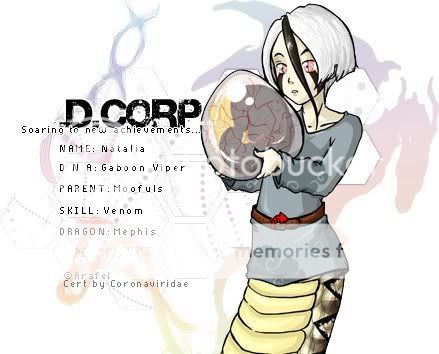|
|
|
|
|
|
|
|
|
 Posted: Wed Dec 13, 2006 12:10 am Posted: Wed Dec 13, 2006 12:10 am
This log belongs to Natalia and Pod (Moofuls).
Do not post unless previously okayed by owner. Those who do without permission will be blacklisted from the shop.
|
 |
 |
|
|
|
|
|
|
|
|
|
|
|
|
 Posted: Wed Jan 17, 2007 1:56 pm Posted: Wed Jan 17, 2007 1:56 pm
.01. D-Corp Post
.02. Navigation
.03. Photos
.04. Events
.05. Natalia
.06. Pod
.07. Lyrus
.08. Dragon
.09. Family
.10. Friends
.11. Gaboon Vipers
.12. Natalia's Room
.13. The House
.14. Links
.15. Post Rules
|
 |
 |
|
|
|
|
|
|
|
|
|
|
|
|
|
|
|
 Posted: Wed Jan 17, 2007 1:57 pm Posted: Wed Jan 17, 2007 1:57 pm
|
|
|
|
|
|
|
|
|
|
 Posted: Wed Jan 17, 2007 1:58 pm Posted: Wed Jan 17, 2007 1:58 pm
|
|
|
|
|
|
|
|
|
|
|
|
|
 Posted: Wed Jan 17, 2007 1:59 pm Posted: Wed Jan 17, 2007 1:59 pm
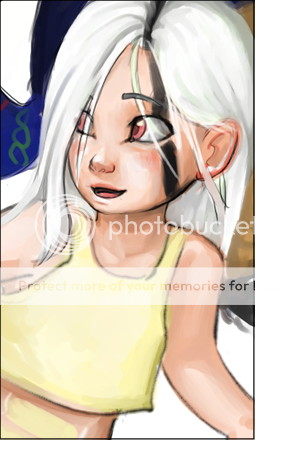 Name: Natalia
Nickname: Nat
Age: Toddler (About 3)
Gender: Female
Animal: Gaboon Viper
Dragon Name: N/A
Dragon Type: N/A
Ability: Venom
Eyes:
Skin:
Hair:
Build:
Distinguishing Markings:
Likes:
Dislikes:
Personality (in short):
|
 |
 |
|
|
|
|
|
|
|
|
|
|
|
|
 Posted: Wed Jan 17, 2007 2:01 pm Posted: Wed Jan 17, 2007 2:01 pm
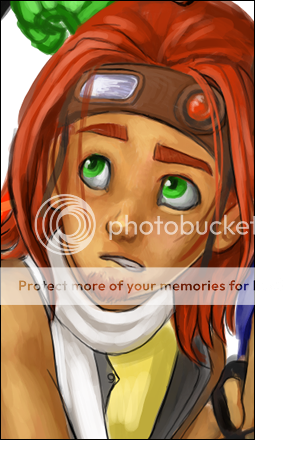 Name: K'Podron Van Quil
Nickname: Pod
Age: Mid-late twenties.
Gender: Male
Species: Periegan
Eyes:
Skin:
Hair:
Build:
Distinguishing Markings:
Likes:
Dislikes:
Personality (in short):
|
 |
 |
|
|
|
|
|
|
|
|
|
|
|
|
|
|
|
 Posted: Wed Jan 17, 2007 2:28 pm Posted: Wed Jan 17, 2007 2:28 pm
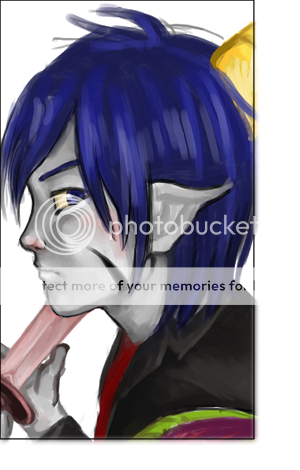 Name: Lyrus
Nickname: ...Lyrus
Age: Late teens
Gender: Male
Species: Sin'aeis
Element: Lamb
Eyes:
Skin:
Hair:
Build:
Distinguishing Markings:
Likes:
Dislikes:
Personality (in short):
|
 |
 |
|
|
|
|
|
|
|
|
|
|
|
|
 Posted: Wed Jan 17, 2007 2:34 pm Posted: Wed Jan 17, 2007 2:34 pm
|
|
|
|
|
|
|
|
|
|
|
|
|
 Posted: Wed Jan 17, 2007 3:03 pm Posted: Wed Jan 17, 2007 3:03 pm
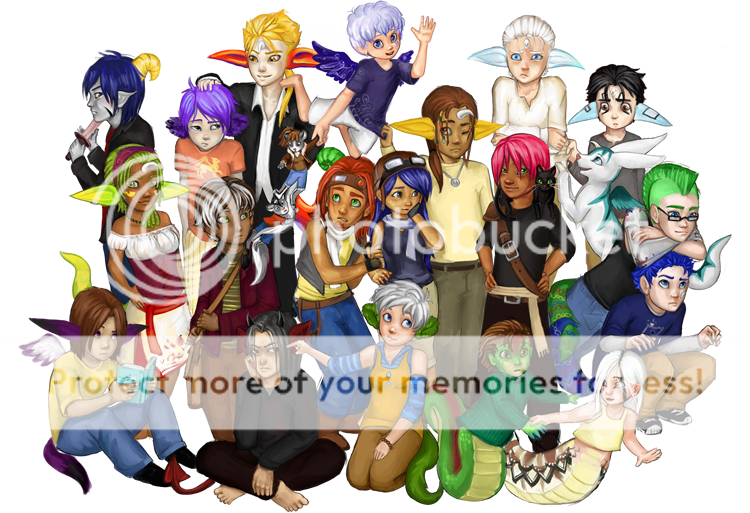 1st: Lyrus, Tayn, Kama, Coen (holding Acia and Bowie), Scion, Klu'chud, 1st: Lyrus, Tayn, Kama, Coen (holding Acia and Bowie), Scion, Klu'chud,
2nd: Caitrione, Banda, Pod, Moofuls, Jack, Jaxom (and his cat), Silthran, Isto (leaning on) Dan,
3rd: Zach, Venoch, Delia, Adroi, and Natalia.
|
 |
 |
|
|
|
|
|
|
|
|
|
|
|
|
 Posted: Wed Jan 17, 2007 3:06 pm Posted: Wed Jan 17, 2007 3:06 pm
|
|
|
|
|
|
|
|
|
|
|
|
|
 Posted: Wed Jan 17, 2007 3:09 pm Posted: Wed Jan 17, 2007 3:09 pm

Bitis gabonica
Common names: gaboon viper, butterfly adder, forest puff adder, swampjack, gaboon adder.
Bitis gabonica is a venomous viper species found in the rainforests and savannas of Sub-Saharan Africa. This is not only the largest member of the genus Bitis, but also the world's heaviest viperid[2] and it has the longest fangs and the highest venom yield of any venomous snake. Two subspecies are currently recognized, including the nominate race described here.
Description: Adults average 122–152 cm in length with a maximum of 205 cm for a specimen collected in Sierra Leone. The sexes may be distinguished by the length of the tail in relation to the total length of the body: approximately 12% for males and 6% for females. Adults, especially females, are very heavy and stout.
In their description of B. gabonica, Spawls et al. (2004) give an average length of 80–130 cm, with a maximum size of 175 cm, saying the species may possibly grow larger still. They acknowledge reports of specimens "over 6 feet", or even over 2 m in length, but claim there is no evidence to support this.
The head is large and triangular, while the neck is greatly narrowed: almost one-third the width of the head. A pair of horns are present between the raised nostrils — tiny in B. g. gabonica, but much larger in B. g. rhinoceros. The eyes are large and moveable,[2] set well forward,[6] and surrounded by 15–21 circumorbital scales. There are 12–16 interocular scales across the top of the head. 4–5 scale rows separate the suboculars and the supralabials. There are 13–18 supralabials and 16–22 sublabials. The fangs may reach a length of 55 mm: the longest of any venomous snake.
Midbody, there are 28–46 dorsal scale rows, all of which are strongly keeled except for the outer rows on each side. The lateral scales are slightly oblique. The ventral scales number 124–140: rarely more than 132 in males, rarely less than 132 in females. There are 17–33 paired subcaudal scales: males have no fewer than 25, females no more than 23. The a**l scale is single.
The color pattern consists of a series of pale, sub-rectangular blotches running down the center of the back, interspaced with dark, yellow-edged hourglass markings. The flanks have a series of fawn of brown rhomboidal shapes, with light vertical central bars. The venter is pale with irregular brown or black blotches. The head is white or cream with a fine, dark central line, black spots on the rear corners, and a dark blue-black triangle behind and below each eye. The iris color is cream, yellow-white, orange[6] or silvery.
Geographic Range: This species can be found in Guinea, Ghana, Togo, Nigeria, Cameroon, DR Congo, Central African Republic, southern Sudan, Uganda, Kenya, eastern Tanzania, Zambia, Malawi, eastern Zimbabwe, Mozambique, northeast KwaZulu-Natal Province in South Africa. The type locality given as is "Gabon" (Africa).
Habitat: Usually found in rainforests and nearby woodlands, mainly at low altitudes, but sometimes as high as 1500 m. Spawls et al. (2004) mention a maximum altitude of 2100 m.
In Tanzania, this species is found in secondary thickets, cashew plantations, and in agricultural land under bushes and in thickets. In Uganda, they are found in forests and nearby grasslands. They also do well in reclaimed forest areas: cacao plantation in West Africa and coffee plantations in East Africa. They have been found in evergreen forests in Zambia. In Zimbabwe, they only occur in the coastal forests, dune regions and remnant mountain forests. The species may also be found in swamps, as well as still and moving waters.
Behavior: Primarily nocturnal, they have a reputation for being slow-moving and placid. They usually hunt by ambush, often spending long periods motionless, waiting for suitable prey to happen by. On the other hand, they have been known to hunt actively, mostly during the first six hours of the night. In Kumasi, Ghana, they were regularly killed around some stables in an open area with the forest some 500 m away — a sign that they were hunting rats in the grassland. They are usually very tolerant snakes, even when handled, and rarely bite or hiss. However, bad-tempered individuals do occur.
Locomotion is mostly rectilinear, in a sluggish "walking" motion of the ventral scales. They may writhe from side to side when alarmed, but only for short distances. Ditmars (1933) even described them as being capable of sidewinding.
If threatened, they may hiss loudly as a warning, doing so in a deep and steady rhythm, slightly flattening the head at the expiration of each breath. They are unlikely to strike unless severely provoked.
There have been numerous descriptions of their generally non-aggressive nature. Sweeney (1961) wrote that they are so docile that they "can be handled as freely as any non-venomous species", although this is absolutely not recommended. In Lane (1963), Ionides explained that he would capture specimens by first touching them lightly on the top of the head with a pair of tongs. Anger was rarely displayed, so that the tongs were usually set aside and the snake firmly grasped by the neck with one hand and the body supported with the other. He said the snakes hardly ever struggled.
Parry (1975) describes how this species has a wider range of eye movement than other snakes. Along a horizontal plane, eye movement can be maintained even if the head is rotated up or down to an angle of up to 45°. If the head is rotated 360°, one eye will tilt up and the other down, depending on the direction of rotation. Also, if one eye looks forwards the other looks back, as if both are connected to a fixed position on an axis between them. In general, the eyes often flick back and forth in a rapid and jerky manner. When asleep, there is no eye movement and the pupils are strongly contracted. The pupils dialate suddenly and eye movement resumes when the animal wakes up.
Feeding: Generally, these snakes are sedentary opportunistic ambush predators, but they will hunt actively, usually starting at dusk. Following a strike, they tend to hold on to their prey until it is dead. Prey is also lifted off of the ground to prevent it getting hold of anything. Anything large enough to pose more of a threat is released and searched for after a few minutes.
These snakes feed on a variety of birds and mammals, such as doves, many different species of rodents, hares and mongooses. There are also reports of more unlikely prey items, such as monkeys, the brush-tailed porcupine (Atherurus) and even the small royal antelope (Neotragus).
Reproduction: During peak sexual activity, males engage in combat. This starts with one male rubbing its chin along the back of the other. The second male will then raise its head as high as possible. As they both do the same, the necks intertwine. When the heads are level, they turn towards each other and push. Their bodies intertwine as they switch positions. They become oblivious to everything else, continuing even after they fall off of a surface or into water. Sometimes they intertwine and squeeze so tightly that their scales stand out from the pressure. They have also been observed to strike at each other with mouths closed. Occasionsally, the combatants will tire and break off the fight by "mutual consent", resting for a while before resuming once more. The event is settled when one of the two succeeds in pushing the other's head to the ground and raising its own by 20–30 cm. In captivity, combat may occur 4–5 times a week until courtship and copulation ends.
Gestation takes about a year, which suggests a breeding cycle of 2–3 years. A 5-year breeding cycle may also be possible. Usually, they give birth in late summer. B. g. gabonica produces 8–43 live young. B. g. rhinoceros may produce as many as 60. However, the actual number of offspring rarely exceeds 24. Neonates are 25–32 cm in length and weigh 25–45 g.
Venom: Bites are relatively rare, due to their docile nature and the fact that their range is mainly limited to rainforest areas. Nevertheless, when it does occur it should always be considered a serious medical emergency. Even an average bite from an average sized specimen is potentially fatal.
The venom itself is not considered particularly toxic. In mice, the LD50 is 0.8–5.0 mg/kg IV, 2.0 mg/kg IP and 5.0–6.0 mg/kg SC. However, the venom glands are enormous and produce the largest quantities of any venomous snake. Yield is apparently related to body weight, as opposed to milking interval.[2] Brown (1973) gives a venom yield range of 200–1000 mg (of dried venom),[9] A range of 200–600 mg for specimens 125–155 cm in length has also been reported. Spawls and Branch (1995) state that from 5–7 ml (450–600 mg) of venom may be injected in a single bite.
A study by Marsh and Whaler (1984) reported a maximum yield of 9.7 ml of wet venom, which translated to 2400 mg of dried venom. They attached "alligator" clip electrodes to the angle of the open jaw of anesthetized specimens (length 133–136 cm, girth 23–25 cm, weight 1.3–3.4 kg), yielding 1.3–7.6 ml (mean 4.4 ml) of venom. Two to three electrical bursts of five seconds each were enough to empty the glands. The snakes used for the study were milked 7–11 times over a 12-month period, during which they remained in good health and the potency of their venom remained the same.
Based on how sensitive monkeys were to the venom, Whaler (1971) estimated that 14 mg of venom would be enough to kill a human being: equivalent to 0.06 ml of venom, or 1/50–1/1000 of what can be obtained in a single milking. Branch (1992) suggested that 90–100 mg would be fatal in humans. Marsh and Whaler (1984) wrote that 35 mg would be enough to kill a man of 70 kg (1/30 of the average venom yield).
In humans, a bite causes rapid and conspicuous swelling, intense pain, severe shock and local blistering. Other symptoms may include uncoordinated movements, defecation, urination, swelling of the tongue and eyelids, convulsions and unconsciousness. Blistering, bruising and necrosis may be extensive. There may be sudden hypotension, heart damage and dyspnoea. The blood may become incoagulable with internal bleeding that may lead to haematuria and haematemesis. Local tissue damage may require surgical excision and possibly amputation. Healing may be slow and fatalities are not uncommon.
Taxonomy: Lenk et al. (1999) discovered considerable differences between the two conventionally recognized subspecies of B. gabonica described above. According to their research, these two subspecies are as different from each other as they are from B. nasicornis. Consequently, Lenk et al. (1999) regard the western form as a separate species, B. rhinoceros.
|
 |
 |
|
|
|
|
|
|
|
|
|
|
|
|
 Posted: Wed Jan 17, 2007 3:13 pm Posted: Wed Jan 17, 2007 3:13 pm
|
|
|
|
|
|
|
|
|
|
|
|
|
 Posted: Wed Jan 17, 2007 3:22 pm Posted: Wed Jan 17, 2007 3:22 pm
 The Jivvin center, which is actually just the home of Moo and and her family, is a large, ancient farmhouse situated on the edge of a magnificent forest, which stretches to the horizon and beyond to the west, north, and east. Immediately behind the house is a small aisle where the trees part, forming a narrow dirt road that winds away into the forest. The path meanders in every which-a-way for some time, finally opening to an immense clearing, somehow untouched by time or even distance.
Built on a large hill in the center of the clearing is an ancient mansion--or is it a newly constructed castle? The image seems to flicker and change from one to the other. The dirt path twines its way towards the mansion, wandering calmly around a large lake and leading up towards the front doors. As you take your first steps from the safety of the forest, some sixth sense seems to warn you against straying from the road. As much as you want to keep going, the distance seems terribly long. Is it really worth it? Before you can take ten steps, you are at the end of the path, standing before the three identical doors of the mansion.
At first glance, they seem normal enough; three large, heavy wooden doors, made exactly alike with a carving of an hourglass on each. But as you look closer, the hourglasses seem to change on each. Tiny, carved grains of sand form from the wood, moving to a different position on each door. On the first door, the sand begins to fall from top to bottom, falling endlessly though vanishing before it touches the bottom. In the second, the sand also falls, though and equal amount constantly remains in top and bottom. And on the third, the sand remains settled on the bottom, still and unmoving.
The middle door seems safest, given the present situation, and as you enter you step into a wide hallway, lined with doors on either side and ending in a magnificent pair double doors, delicately carved of dark cherrywood. This doorway, usually open, leads to a magnificent marble staircase, and, beyond that, the Grand Ballroom--rarely used by anyone--, which takes up the larger part of the rear of the house, and stretches up to include the second floor.
The first floor is simply, yet elegantly decorated, usually kept to a strictly formal atmosphere, though its inhabitants certainly don't follow along. The left side of the first floor is compose primarily of a large kitchen and dining room; from there another smaller hallyways leads to to labs (Moo's and Acia's), an art studio (Banda's), the downstairs armory, a bathroom, the storeroom/garage and a smaler staircase to the second floor.
The right side of the first floor, meanwhile, includes a smaller staircase of its own, the living room, the den, two offices (Moo's private office and the main Jivvin one), two master bedrooms (Moo's and Pod's), and the 'Egg Room', which is kept locked at almost all times.
The second and third floors of the house are primarily smaller bedrooms for the rest of the members of the household, but, as before stated, the ballroom takes up a large area of the second floor, and there is a larger meeting room stationed at the end of each wing should they be needed.
Also, the entire midsection of the third floor has been devoted to an immense private library. Hundreds of rare books line the shelves, many possibly the only ones of their kind left in existance, but there are many empty spaces where books have gone missing, and the library itself is messy and unorganized--for the most part. A few simply tables and many comfortable armchairs are situated around the library for whoever might want them; books are free to come and go, but automatically return if kept away too long... How odd.
The fourth floor is all but empty, devoid of life or decoration save for one small room near the staircase, where various charmed weapons and armor are stored--a relic from the House's Past. The fourth floor serves as a barrier between the safety of the lower floors and the dangers of the Fifth. The only two doors are almost always kept locked, just on the off chance that some wayward spirit might escape...
Little is known of the Fifth floor. Its single door is kept locked and barred at all times, and an eerie glow seems to surround it. Rumors tell of demons, spirits, warped creatures trapped within by the powers surrounding the House. And some of the household's members will swear to these rumors, claim to have seen these creatures, fought them away... But who can be sure. Many illusions surround the House. This could simply be another.
|
 |
 |
|
|
|
|
|
|
|
|
|
|
|
|
 Posted: Wed Jan 17, 2007 3:26 pm Posted: Wed Jan 17, 2007 3:26 pm
|
|
|
|
|
|
|
|
|
|
|
|
|
 Posted: Wed Jan 17, 2007 3:28 pm Posted: Wed Jan 17, 2007 3:28 pm
General:
@This is an IC journal. All OOC comments should be kept to a minimum, and in brackets if used.
@Nothing is for sale here. Nothing. So don''t ask.
@Don''t post unless you have permission. Period.
@Moofuls can edit rules whenever needed.
People allowed to post:
>Arafel.
>D-Corp guardians.
>Jivvins owners.
>SkullMonkey owners.
>Sin'aeis guardians.
>MM guardians.
>GMFC parents & children.
>Any other RP breedable I am a part of''s guardians.
This is all providing that one does not interrupt an ongoing RP, Quest, etc. If it looks like you''d be interrupting something, PM Moofuls with the gift/concern/etc.
Credits:
Original Credits (c) Xbear, edited with permission.
Character art (c) Arafel.
''Friends'' box art (c) Arafel.
All other art (c) their respective artists.
Banners, dividers, and graphic art (c) Moofuls unless otherwise stated.
Natalia (c) Moofuls. Steal and die.
D-Corp concept (c) Arafel.
Any other characters seen here (c) their players.
|
 |
 |
|
|
|
|
|
|
|
|
 |
|
|
|
|
|
|
